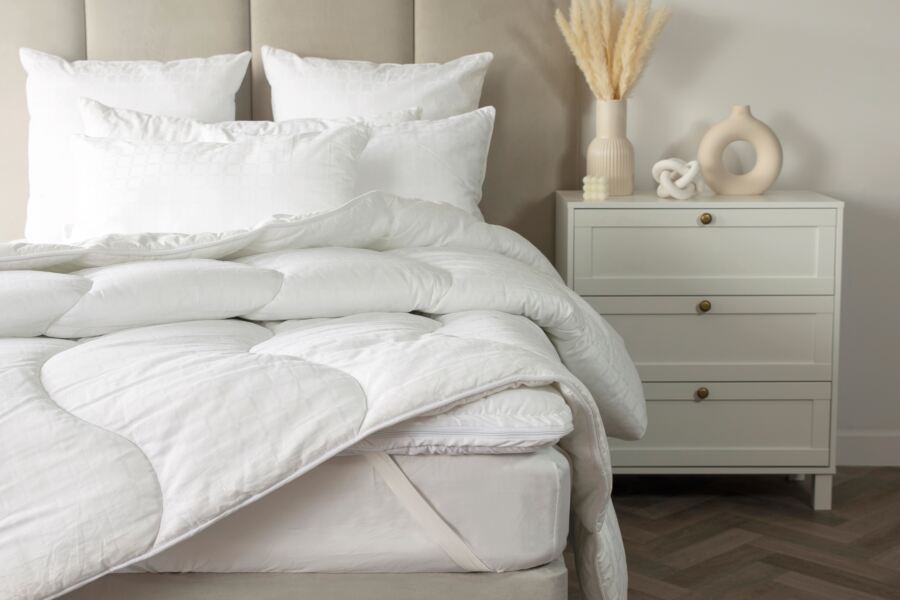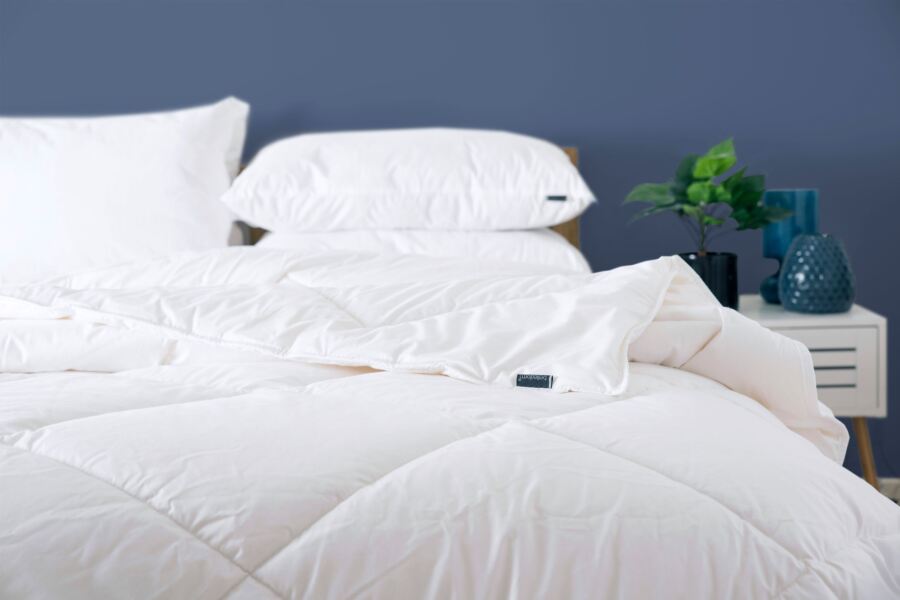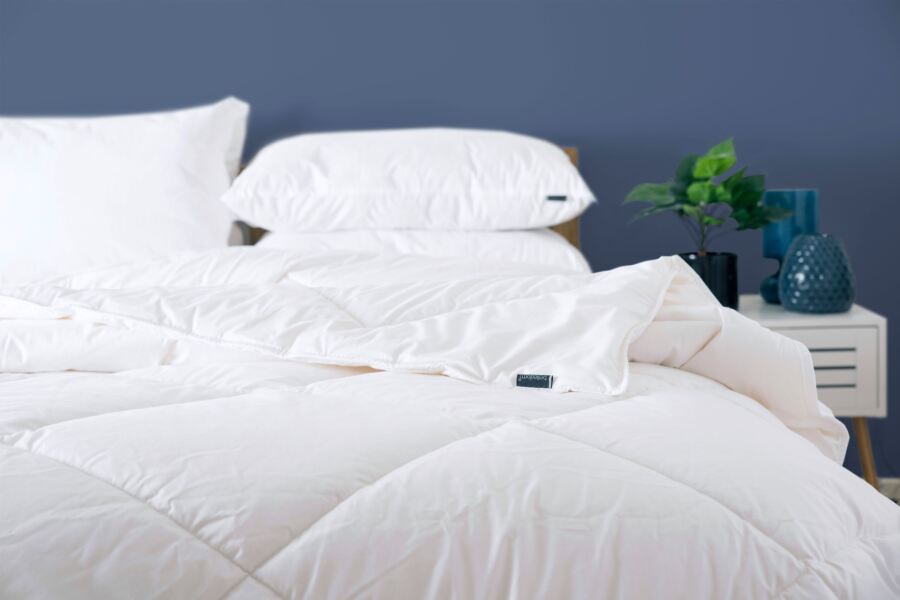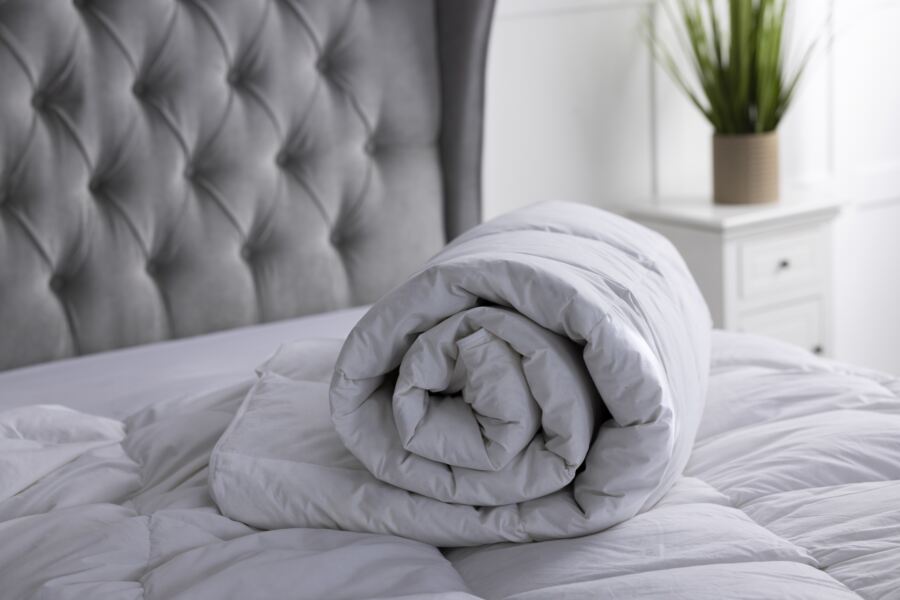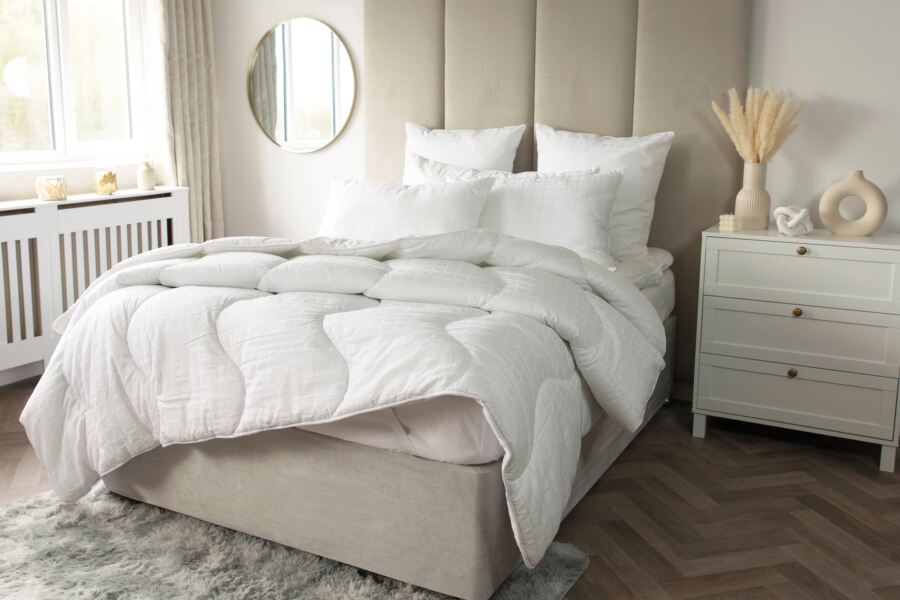Table of Contents
- What Tog Duvet Should I Get?
- Choosing Your Preferred Duvet Filling
- How To Choose The Right Duvet By Season
- How To Choose Your Duvet Size
- FAQs
- Conclusion
Choosing a duvet is not always as simple as walking into a store and buying the first one that catches your eye. There are a couple of things you need to consider first - like the tog rating and the fill power.
If these terms are foreign to you, don't worry! We explain it all in our guide below.
Read on to find out more about how to choose the right duvet according to your needs, preferences, and season.

What Tog Duvet Should I Get?
We all know that maintaining a comfortable body temperature at night time is key to a good night's rest.
This is where tog ratings come into play. A tog rating is a measure of the warmth of a duvet. The higher the tog rating, the warmer the duvet.
A lower tog rating (5 and lower) offers little warmth and is ideal for summer months. A higher tog rating (12-15) does a good job of trapping warm air around you, helping you to stay warm during colder nights.
What if I want a duvet I can use all year round?
Buying a duvet with a tog rating somewhere in the middle makes sense for all-season use.
A tog duvet rating of 10.5 is a great choice for flexibility, bordering on what would be considered "too hot" and "not warm enough", depending on the season.
Another option would be to buy two separate duvets with different tog ratings. For example, if you buy a tog 5 and a tog 8 duvet, you will have a range of warmth options by using them separately or combining them when needed. The 5-tog duvet can be used during summer, the 8-tog during spring and autumn, and both duvets combined (13-tog) for winter.
Choosing Your Preferred Duvet Filling
The filling in your duvet can have a big impact on the quality of your sleep. If it’s too heavy or too light, it can interrupt your sleep or leave you feeling too hot or cold. Some fillings are also known to trigger allergies, so it's good to know which fillings to avoid if you are someone who commonly has reactions to things like dust mites or pet dander.
Feather-filled duvets offer a soft, luxurious, and light sleep, while synthetic duvets are a great option for those looking for warmth and an allergy-free sleeping experience.
Need more guidance on the type of duvet filling to choose? Read on about the different types of duvet fillings below.
Synthetic fillings
There are a few reasons why synthetic fillings might be the best choice for you.
As previously mentioned, synthetic duvets (also called non-allergenic) are great for those who suffer from allergies, such as feather, down, or dust mite allergies.
Synthetic fibres are also more durable than natural fibres. While natural fibres wear out over time and need to be replaced, synthetic fibres maintain their quality for longer. This saves you money and time in the long term. The fillings are also easier to care for - they are easy to wash, quick to dry, and have a higher resistance to stains.
Finally, synthetic fibres are usually more effective at insulating against cold temperatures than natural ones are - and we all know how important that is when winter comes around!
Options for synthetic fillings include the following:
-
Hollowfibre
Hollowfibre duvets are known for being extremely breathable. They are designed with spacing between the fibres, which is also great for a lightweight feel. On the other hand, microfibre has a tightly knit fabric fill. This construction provides warmth and plumpness without being too heavy.

Natural fillings
If you’re looking for a natural duvet filling, you have a lot of options.
One of the pros of buying natural fillings is that they are better for the environment. They're sustainable and don't use chemical treatments to keep them soft and fluffy.
Natural fillings also offer more comfort thanks to the higher loft (puffiness). This helps the duvet to feel soft on your skin, guaranteeing a cosy sleep that will make you want to hit snooze again and again!
Options for natural duvet fillings include:
-
Feather-filled
-
Down-filled
Feather duvets are lightweight and don't retain moisture. This makes them a popular choice for people in warmer climates or during summer months. Down is the softer and lighter feathers that are collected from a bird during moulting season. These fibres are very durable and typically last much longer than other duvet fillings.
Some people opt to buy a combination of feather and down-filled duvets. A mix of the two offers an ideal warmth and weight and is also more affordable than buying a purely down-filled duvet.
Silk duvet fillings are a popular choice for those who prioritise comfort. It's also a great option for those who want something light and temperature-regulating. Additionally, wool is another natural fibre that's good for comfort and controllable warmth. Wool does a brilliant job at trapping warmth while wicking away excess moisture, so you don't feel stuffy.
How To Choose The Right Duvet By Season
It's a good idea to have multiple duvets on hand that you can use for every season. One for winter, one for summer, and one for the seasons in between. These duvets should differ according to three things: tog rating, filling, and fill power.
We've already covered tog ratings and fillings, but what is fill power?
Fill power is a measure that is used to determine the "fluffiness" of down or synthetic fillings. The fill power number tells you how much space one ounce of the filling takes up. A high fill power indicates higher quality and higher insulation.
Winter duvets
Your winter duvet should have a high tog rating and a higher fill power to keep you warm and comfortable.
For example, a down duvet with a tog rating of 10.5 or higher and a fill power of 600 or higher will keep you nice and toasty during chilly winter nights. You could also opt for a synthetic filling with the same tog and fill power as above. Both options will offer more or less the same amount of warmth.
The deciding factor between natural and synthetic fillings in this case may come down to factors like affordability, eco-friendliness, and the likeliness of the fillings to trigger allergies.
Summer duvets
During summer, you'll want a lighter duvet that won't make you too hot while you sleep. You'll need something that doesn't trap too much heat and has high breathability.
An ideal summer duvet has a tog rating of about 3-5 and a fill power of no higher than 400. Additionally, consider using a breathable duvet cover that will allow air to circulate. Breathable covers are made of natural fibres like cotton or linen.
If you prefer natural bedding, your summer duvet should have silk, wool, feather or down filling. If you prefer synthetic fillings, you should go with a hollowfibre filling. These fillings are highly breathable and moisture-wicking, meaning that you won't need to worry about a damp bed if you get hot during the night.

How To Choose Your Duvet Size
Choosing the right duvet size is also important for a good night's sleep. You need to make sure that you have enough coverage - especially if you're someone who likes to cocoon yourself in the covers.
The first step is to know your bed size. You can do this by measuring your bed's length and width and then consulting a bedding size chart. All bedding size measurements are listed below:
-
Small Single: 75cm x 190cm
-
Small Double (Queen): 120cm x 190cm
The second step is more preference-based. Consider how much of a drop you want over the sides of your bed. You may prefer a longer or shorter drop depending on what you think looks best - and this will influence the size duvet you need.

FAQs
Is a natural or synthetic duvet better?
Natural duvets are better for people who are looking for highly breathable, lightweight, and eco-friendly materials. These include materials like down, feathers, wool, and silk. Synthetic fillings like microfibre and hollowfibre are more cost-effective and easier to care for. They are also non-allergenic, meaning that they won't trigger any allergies.
What duvets do five-star hotels use?
Most high-end hotels use down duvets with a thread count between 300 and 400. These duvets offer softness, comfort, and durability.
When should I change my duvet?
In general, you should replace your duvet every 5-10 years or as soon as you notice that it's lost its shape and comfort. However, this time frame can differ depending on the quality and durability of the duvet you buy.
Conclusion
Which duvet is the right one for you depends on several factors. When choosing between a natural or synthetic filling, you need to think about things like breathability, feel, weight, and affordability. Tog rating and fill power are also things to consider, as they will determine the warmth and quality. Lastly, make sure to choose a duvet size that matches the size of your bed.

